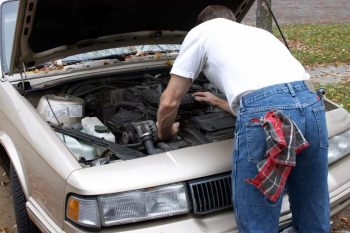How to:
- Park your vehicle on a level spot.
- When the engine is cool, lift the hood and locate the dipstick.
- Pull the dipstick out and wipe off any oil with a clean rag or paper towel.
- Reinsert the dipstick, push it all the way in, and then remove it again.
- Check the oil level on the stick. It should be at or below the max level but above the minimum level.
- Top off the oil level if needed and make sure the dipstick is returned to its proper place.
Note: If the oil looks dirty or is significantly low, it may be time for an oil change or there may be a leak. In either case, it’s a good idea to schedule an appointment for service at your local auto repair shop.
#2: Know how to check tire pressure.
How to:
- Locate your tire pressure gauge.
- Check your owner’s manual or the panel on the inside of the driver’s side door for the manufacturer’s recommended tire pressure level.
- Unscrew the valve stem cap on the tire you’re checking.
- Press the tire pressure gauge onto the valve stem.
- Read the gauge to determine the current tire pressure level.
- If the tire pressure is low, add more air as needed.
#3: Be able to change a flat tire.
How to:
- Park your vehicle in the safest place possible, ideally on flat ground and away from traffic.
- Turn on your hazard lights to alert other drivers and improve safety.
- Get out your jack, wrench, and spare tire.
- Loosen the tire’s lug nuts and then lift your vehicle with the jack.
- Remove the lug nuts and flat tire.
- Put your spare tire on the car and affix the lug nuts.
- Lower your vehicle to the ground and make sure the lug nuts are tight before driving.
#4: Know how to check your tires’ condition.
How to:
- To check overall tire condition, visually inspect for lumps, bulges, nails, screws or anything else that has penetrated the tire. If you find something, schedule an appointment for tire service at your local auto repair shop as soon as possible.
- To check tire tread, hold a quarter upside down between the tire treads in multiple areas. If you’re ever able to see the top of George Washington’s head, it’s time to consider getting a new set of tires.
#5: Be able to jumpstart your vehicle.
How to:
- Locate another vehicle with a fully functioning battery.
- Make sure both vehicles are in neutral and turned off.
- Locate your owner’s manual and follow the instructions for attaching your jumper cables.
- When all the connections have been properly made, start your vehicle.
- Keep your vehicle running or drive it for at least 30 minutes to recharge the battery.
Why Are These Car Maintenance Skills Necessary?
Some of these car maintenance items, such as changing a flat tire or jumpstarting your car, can be handled by roadside assistance organizations like AAA. So why bother learning these car maintenance skills for yourself? Well, it’s certainly possible that there could be a time when you’re in an area without cell phone service to call for assistance. Or, you could be forced to wait hours for help to arrive. In these cases, having these skills in your tool belt will be well worth it!























